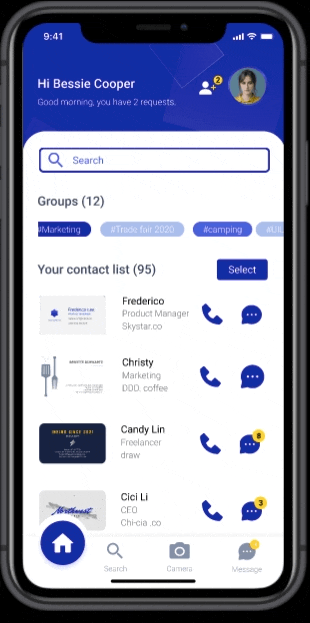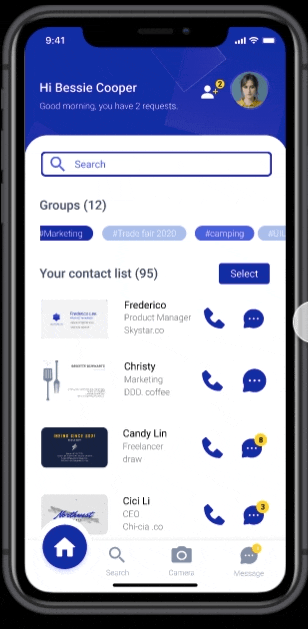UX Design Portfolio

Cardtain
Captain your work with Cardtain! Specially designed for Taiwanese, An ultimate solution to all networking scenarios.
What is the problem?
Have you been to a work event that brings you to meet dozens of people?
Everything was running so fast. There was only time for short introductions and business cards exchange between you and them before one of you had to quickly move on to the next. You pulled yourself together and stayed focused in order to develop professional connections. When the event was finally over, you knew it was a fruitful day but couldn't help to feel lost in the handful of name cards and vague memories of people you just made the acquaintance of.
-
How do you smartly digitize name card data without disobeying data protection regulation?
-
How do you keep these business connections alive and intimate without infringing upon your personal life?
-
One step further, how do you proactively expand connections when there is no networking event avalible?
These are the pain points we've experienced ourselves and the inspiration for us to kick off this project.


Who are the users?
Our target users are generally all the professionals who have to build up and maintain connections with others. We focus on the local market here in Taiwan where professional and personal lives are involuntarily
intertwined on chat apps.
How to emotionally connect with users?
First of all, we asked ourselves what’s the unfulfillment in current business networking options?
If you ask around local professionals in Taiwan “Why don’t you use linkedIn?” You might get the If you ask local professionals around in Taiwan “Why don’t you use LinkedIn?” You may get the answer "Because nobody is using it." That is true, but how so? Are there more cultural clues behind this phenomenon?
LinkedIn is the place people openly connect with their past and current work contacts, which means a full exposure of professional history to the public. In terms of work, Taiwanese tend to avoid putting all of their past on the table. However, people still need a platform for business networking, with the way they want to be seen.
-
Let users have control
That's why we allow our users to create multiple name cards of their own and toggle between them, which means they can decide their role when they connect to a specific person.
-
Make users feel secure
Our users can request for a connection by sending out a name card of their choice. Noone will be judged by their previous job title or work history, and this fact will make them feel more secure in a networking scenario.
To avoid anxiety and stress coming up with unlimited exchanges of expressions, Cardtain excludes social media feed functionality and encourages direct messages for interaction instead to generate more intimate connections between people.
Emphasize with the users: Interview
We conducted structured one-on-one interviews to collect in-depth information on people's opinions, experiences, and feelings about business cards and their relative scenes, which effectively helped us to emphasize with different user groups.
Research Goals
-
Why or why not a digital business card app? How do people store other's data?
-
What are the struggles? How do people maintain and expand business connections?
-
How do people communicate with their business contacts? What are the wishes?
Insights
-
Unlike Western countries, Linkedin does not play an important role in local recruitment and business culture. The lack of a platform for professional networking limits professionals’ options to expand connections.
-
Taiwanese professionals are used to conducting business communication on messaging apps, such as LINE and Messenger. The mix of private and business contacts in one app eventually leads them to an imbalance between personal life and work.
-
Digitizing an EU citizen's business card on behalf of a company without consent documents is considered to be a transgression against GDPR.


Define, Ideate, Design

Define
Value Proposition
During the definition phase, we went through problem statement, hypothesis statement and value proposition in order to better summarize users' pains and needs, also to propose potential solutions.
Ideate
Competitive Audit
We initiated the ideation phase with a competitive audit. From looking into current solutions offered by opponents and their strengths and flaws, we gain clearer ideas of how a name card app can evolve and how our product will fit in our users' lives.


Design
User Flow
Through user story maps and storyboards, we've predicted and explored users' journeys both with and without the product. Now we string them all together and create this user flow to make sure all the key needs from users are covered and the transitions between functions are smooth.
